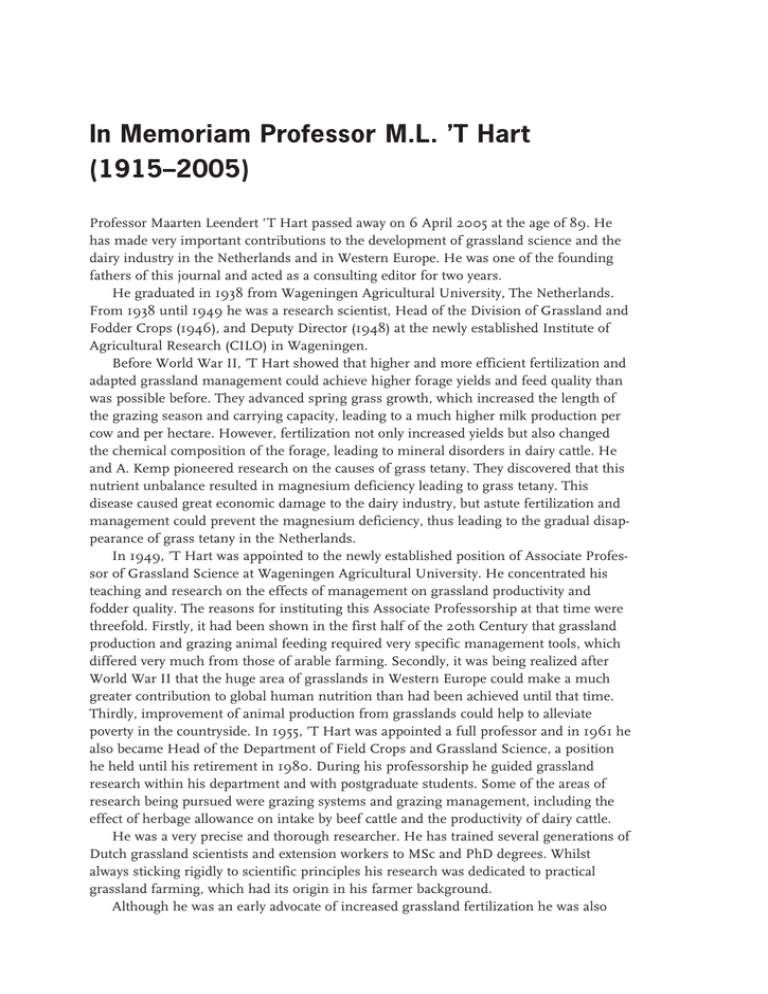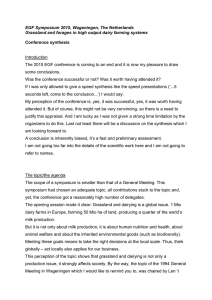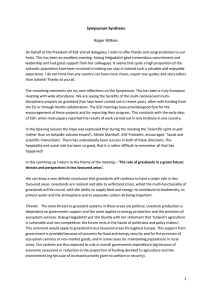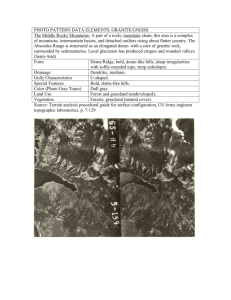In Memoriam Professor M.L. ’T Hart (1915–2005)
advertisement

In Memoriam Professor M.L. ’T Hart (1915–2005) Professor Maarten Leendert ’T Hart passed away on 6 April 2005 at the age of 89. He has made very important contributions to the development of grassland science and the dairy industry in the Netherlands and in Western Europe. He was one of the founding fathers of this journal and acted as a consulting editor for two years. He graduated in 1938 from Wageningen Agricultural University, The Netherlands. From 1938 until 1949 he was a research scientist, Head of the Division of Grassland and Fodder Crops (1946), and Deputy Director (1948) at the newly established Institute of Agricultural Research (CILO) in Wageningen. Before World War II, ’T Hart showed that higher and more efficient fertilization and adapted grassland management could achieve higher forage yields and feed quality than was possible before. They advanced spring grass growth, which increased the length of the grazing season and carrying capacity, leading to a much higher milk production per cow and per hectare. However, fertilization not only increased yields but also changed the chemical composition of the forage, leading to mineral disorders in dairy cattle. He and A. Kemp pioneered research on the causes of grass tetany. They discovered that this nutrient unbalance resulted in magnesium deficiency leading to grass tetany. This disease caused great economic damage to the dairy industry, but astute fertilization and management could prevent the magnesium deficiency, thus leading to the gradual disappearance of grass tetany in the Netherlands. In 1949, ’T Hart was appointed to the newly established position of Associate Professor of Grassland Science at Wageningen Agricultural University. He concentrated his teaching and research on the effects of management on grassland productivity and fodder quality. The reasons for instituting this Associate Professorship at that time were threefold. Firstly, it had been shown in the first half of the 20th Century that grassland production and grazing animal feeding required very specific management tools, which differed very much from those of arable farming. Secondly, it was being realized after World War II that the huge area of grasslands in Western Europe could make a much greater contribution to global human nutrition than had been achieved until that time. Thirdly, improvement of animal production from grasslands could help to alleviate poverty in the countryside. In 1955, ’T Hart was appointed a full professor and in 1961 he also became Head of the Department of Field Crops and Grassland Science, a position he held until his retirement in 1980. During his professorship he guided grassland research within his department and with postgraduate students. Some of the areas of research being pursued were grazing systems and grazing management, including the effect of herbage allowance on intake by beef cattle and the productivity of dairy cattle. He was a very precise and thorough researcher. He has trained several generations of Dutch grassland scientists and extension workers to MSc and PhD degrees. Whilst always sticking rigidly to scientific principles his research was dedicated to practical grassland farming, which had its origin in his farmer background. Although he was an early advocate of increased grassland fertilization he was also well aware that high rates of nitrogen and phosphate could lead to environmental problems and he was of the opinion that research into the use of white clover and lucerne deserved more attention. He played an important scientific role with the nitrogen pilot farm scheme, in which private dairy farms were involved in on-farm research to achieve correct, efficient, profitable and sustainable farm management. Professor ´T Hart was a sought-after consultant within and outside Europe in temperate and tropical regions and attended and addressed several international grassland congresses. He took the initiative to the formation and was the first president of the Netherlands Society for Grassland and Fodder Crops. Dr, later Sir William Davies and he were the founding fathers of the European Grassland Federation (EGF) at Hurley in 1963 and ’T Hart became its first president. The first General Meeting of the EGF was held in Wageningen in 1965 to discuss the theme ‘Nitrogen and Grassland’. From the start of EGF ‘T Hart saw the need to involve grassland scientists from the whole of Europe. He was also a strong supporter of the use of English as the official EGF language. During his career he attended many General Meetings and symposia of the EGF and thus many scientists in Europe had the opportunity to learn from his experience. When he turned 65 in 1980, the EGF organized a symposium in the Netherlands on ‘the role of nitrogen in intensive grassland production’, which discussed the positive as well as negative effects of increased intensification. In the same year Professor ’T Hart was awarded the Honorary Life Presidency of EGF. Professor ’T Hart had a very amiable personality, was calm and modest and would not easily seek attention. When he noticed that things were not going right he would speak up in no uncertain terms. We feel privileged to have known him for many years. Even in the last weeks of his life his mind remained razor sharp and he continued his interest in grasslands. During the preparation of an article on the history of EGF for Grass and Forage Science (2004) Professor ´T Hart proved to be a valuable source. Professor ´T Hart left his mark on grassland science and practice. He will be remembered with great appreciation. Wageningen, 20 May 2005 L.’T Mannetje and W.H. Prins






